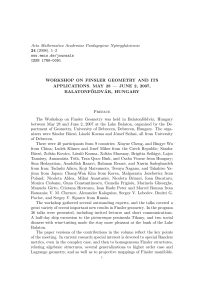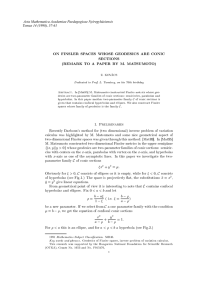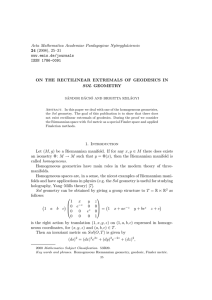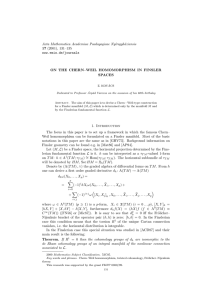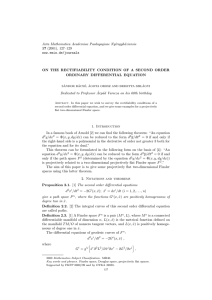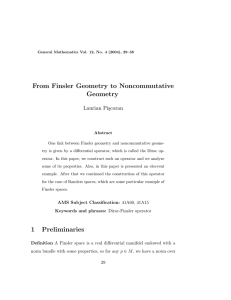Acta Mathematica Academiae Paedagogicae Ny´ıregyh´ aziensis 32
advertisement
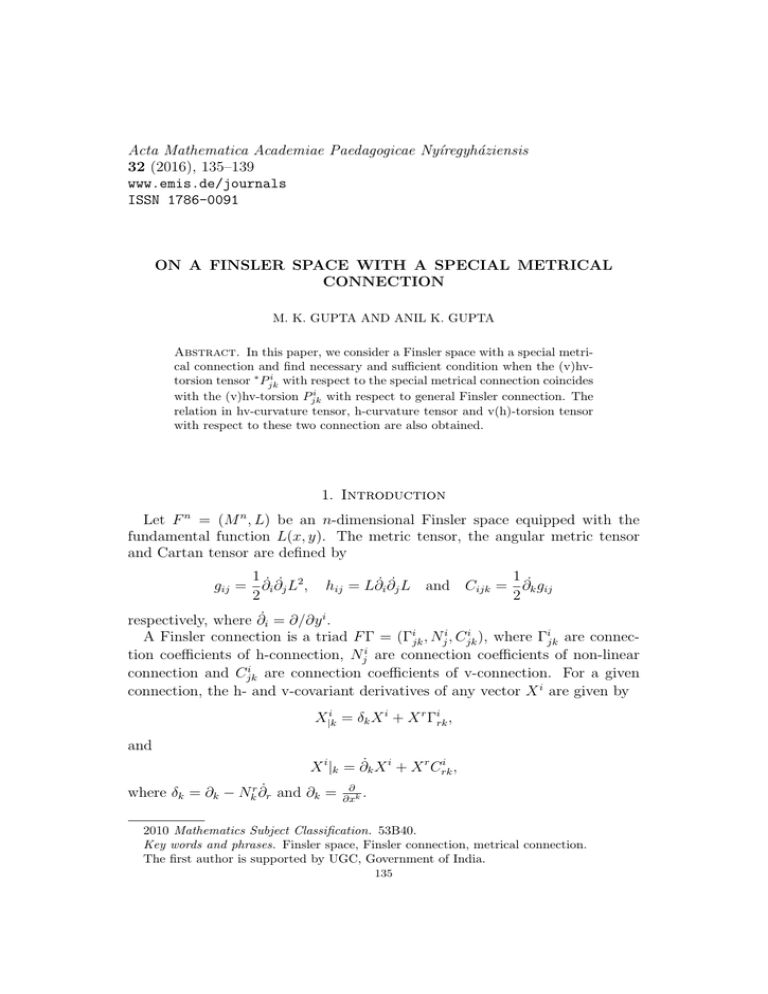
Acta Mathematica Academiae Paedagogicae Nyı́regyháziensis 32 (2016), 135–139 www.emis.de/journals ISSN 1786-0091 ON A FINSLER SPACE WITH A SPECIAL METRICAL CONNECTION M. K. GUPTA AND ANIL K. GUPTA Abstract. In this paper, we consider a Finsler space with a special metrical connection and find necessary and sufficient condition when the (v)hvi torsion tensor ∗ Pjk with respect to the special metrical connection coincides i with the (v)hv-torsion Pjk with respect to general Finsler connection. The relation in hv-curvature tensor, h-curvature tensor and v(h)-torsion tensor with respect to these two connection are also obtained. 1. Introduction Let F n = (M n , L) be an n-dimensional Finsler space equipped with the fundamental function L(x, y). The metric tensor, the angular metric tensor and Cartan tensor are defined by 1 gij = ∂˙i ∂˙j L2 , 2 1 hij = L∂˙i ∂˙j L and Cijk = ∂˙k gij 2 respectively, where ∂˙i = ∂/∂y i . i A Finsler connection is a triad F Γ = (Γijk , Nji , Cjk ), where Γijk are connection coefficients of h-connection, Nji are connection coefficients of non-linear i connection and Cjk are connection coefficients of v-connection. For a given connection, the h- and v-covariant derivatives of any vector X i are given by X|ki = δk X i + X r Γirk , and i X i |k = ∂˙k X i + X r Crk , where δk = ∂k − Nkr ∂˙r and ∂k = ∂ . ∂xk 2010 Mathematics Subject Classification. 53B40. Key words and phrases. Finsler space, Finsler connection, metrical connection. The first author is supported by UGC, Government of India. 135 136 M. K. GUPTA AND A. K. GUPTA i In 2006, H. S. Park et.al. [4] defined a new non-linear connection N j with the help of given non-linear connection Nji for an (α, β)-metric as yi i N j = Nji + ∇j L , L where ‘∇j ’ denotes the covariant derivative with respect to the associated Riemannian connection. In 2008, H. G. Nagaraja [3] defined a new non-linear connection ∗ Nji with the help of given non-linear connection for Randers space as (1.1) L|j y i (1.2) = + , L where ‘|j ’ denote the covariant derivative with respect to Finsler connection i F Γ, and find a new Finsler connection ∗ F Γ = (Γijk ,∗ Nji , Cjk ). n In this paper, we consider a Finsler space F admitting the Finsler connection ∗ F Γ and we find a relation between v(hv)-torsion tensors with respect to these two Finsler connection connections F Γ and ∗ F Γ. We obtain necessary and sufficient condition that two (v)hv-torsions coincides. We also find relation in hv-curvature tensor, h-curvature tensor and v(h) torsion tensor with respect to these two Finsler connections. The Terminology and notion are referred to [2, 5]. ∗ Nji Nji 2. A special metrical connection i Let F n = (M n , L) be an n-dimensional Finsler space and F Γ = (Γijk , Nji , Cjk ) n n be a Finsler connection. Let the Finsler space F = (M , L) admits a new i Finsler connection ∗ F Γ = (∗ Γijk ,∗ Nji , Cjk ), which is h(h)-torsion free and non∗ i linear coefficients Nj are given by (1.4). Then we have L|k y r ˙ L|k y r ˙ ∂r = δk − ∂r . L L The h-covariant derivative of L with respect to ∗ F Γ is given by (2.1) ∗ δk = ∂k −∗ Nkr ∂˙r = ∂k − Nkr ∂˙r − L|k y r ˙ ∂r L = δk L − L|k = 0. L Therefore the Finsler connection ∗ F Γ is h-metrical. Since ∗ F Γ is h-metrical i and h(h)- torsion ∗ Tjk is zero, the linear connection coefficients ∗ Γijk of ∗ F Γ are given in [1] by (2.2) L∗ |k =∗ δk L = δk L − 1 Γijk = g ir Γjrk = g ir [δj grk + δk grj − δr gjk ]. 2 j Using (2.1) and (∂˙j gik )y = 0 in (2.3), we have (2.3) (2.4) ∗ i Γjk = Γijk . i i Thus, the new connection ∗ F Γ = (∗Γijk ,∗ Nji , Cjk ). ) reduces to ∗ F Γ = (Γijk ,∗ Nji , Cjk ON A FINSLER SPACE WITH A SPECIAL METRICAL CONNECTION 137 i The (v)hv-torsion tensor. The (v)hv-torsion tensor Pjk of a Finsler space with respect to connection F Γ is defined by i Pjk = ∂˙k Nji − Γijk . i Therefore the (v)hv-torsion tensor ∗ Pjk of a Finsler space with respect to the ∗ connection F Γ is given by ∗ i Pjk = ∂˙k∗Nji −∗ Γijk . Using (1.2) and (2.4), we get ∗ (2.5) i i Pjk = Pjk + lk|j li + L|j hik . L hi i i . Then equation (2.5) implies that lk|j li + L|j Lk = 0. = Pjk Let us suppose ∗ Pjk Transvecting by yi and using hik yi = 0, we get Llk|j = 0, which gives lk|j = 0. Conversely, let lk|j = 0. Also let us assume that deflection tensor Dji for the Finsler connection F Γ is zero, i.e. Dji = 0. Then we get y|ji = 0. Again lk|j = 0 i i and y|ji = 0, implies that L|j = 0, and hence equation (2.5) yields ∗ Pjk = Pjk . Thus, we have: Theorem 2.1. Let the Finsler space F n admits a Finsler connection F Γ with i i zero deflection tensor and a Finsler connection ∗ F Γ. Then ∗ Pjk = Pjk if and only if lk|j = 0. Rephrasing, the theorem concludes that (v)hv-torsion tensors with respect to Finsler connections F Γ and ∗ F Γ are equal if and only if covariant differentiation of directional derivative of Fundamental metric function L vanishes. i The hv-curvature tensor. The hv-curvature tensor Phjk of a Finsler space with respect to connection F Γ is defined by i i i m Phjk = ∂˙k Γihj − Chk|j + Chm Pjk . i Therefore the hv-torsion tensor ∗ Pjk of a Finsler space with respect to connec∗ tion F Γ is given by ∗ i i i ∗ m Phjk = ∂˙k∗ Γihj − Chk|j + Chm P jk . Using (2.4) and (2.5) we get (2.6) ∗ i i i Phjk = Phjk + Chm hm k L|j . L Thus, we have: Theorem 2.2. Let the Finsler space F n admits the Finsler connections F Γ i and ∗ F Γ. Then expression for ∗ Phjk is given by (2.6). 138 M. K. GUPTA AND A. K. GUPTA i i Let us suppose that ∗ Phjk = Phjk . Then equation (2.6) implies that L|j = 0, L = 0, i.e. the space is Riemannian. Thus, we have: i Chm hm k i which gives Chm Theorem 2.3. If hv-curvature tensor with respect to Finsler connections F Γ and ∗ F Γ coincides, then the space will be Riemannian. i of a Finsler space with The v(h)-torsion tensor. The v(h)-torsion tensor Rjk respect to connection F Γ is defined by i Rjk = δk Nji − δj Nki . i Therefore the v(h)-torsion tensor ∗ Rjk of a Finsler space with respect to con∗ nection F Γ is given by ∗ i Rjk = ∗ δ k ∗ N ij − ∗ δ j ∗ N ik . Using (1.2) and (2.1) and simplification gives us ∗ (2.7) i i i Rjk = Rjk + [L|j|k li + L|j l|k − L|k lr lr|j li − j/k], where −j/k denotes interchange of j and k and subtract the terms within the bracket. Theorem 2.4. Let the Finsler space F n admits the Finsler connections F Γ i and ∗ F Γ. Then expression for ∗ Rjk is given by (2.7). Equation (2.7) can be re-written as ∗ = i Rjk + [(L|j|k − L|k|j )l + L|j i y|k y|ji y|jr r y|k − L|k + L|k l l − L|j lr li ]. L L L L i Let us assume that deflection tensor Dj for the Finsler connection F Γ is zero i.e. Dji = 0. Then we get y|ji = 0 and then equation (2.8) becomes (2.8) i Rjk i ∗ (2.9) r i i i Rjk = Rjk + (L|j|k − L|k|j )li . Thus, we have: Corollary 1. Let the Finsler space F n admits the Finsler connection F Γ with zero deflection tensor and a Finsler connection ∗ F Γ. Then v(h)-torsion tensor ∗ i Rjk for the connection ∗ F Γ is given by (2.9). i The h-curvature tensor. The h-curvature tensor Rhjk of a Finsler space with respect to connection F Γ is defined by m i i i m i i + δk Γihj + Γm Rjk = Chm Rhjk hj Γmk − δj Γhk − Γhk Γmj . i Therefore the h-curvature tensor ∗ Rjk of a Finsler space with respect to con∗ nection F Γ is given by ∗ m i ∗ i i i ∗ m i = Chm Rjk + ∗ δ k Γihj + Γm Rhjk hj Γmk − δ j Γhk − Γhk Γmj . ON A FINSLER SPACE WITH A SPECIAL METRICAL CONNECTION 139 Using (2.1) and (2.7) and simplifying, we obtain ∗ i i i m (2.10) Rhjk = Rhjk − (L|k lr ∂˙r Γihj − L|j lr ∂˙r Γihk ) + Chm [L|j l|k − L|k l|jm ]. Thus, we have: Theorem 2.5. Let the Finsler space F n admits Finsler connections F Γ and i is given by (2.10). F Γ. Then expression for ∗ Rhjk ∗ Equation (2.10) can be re-written as (2.11) ∗ i i i Rhjk = Rhjk − L|k lr ∂˙r Γihj + L|j lr ∂˙r Γihk + Chm [L|j m y|k − L|k y|jm ]. L L Also let us assume that deflection tensor Dji for the Finsler connection F Γ is zero, i.e. Dji = 0. Then we get y|ji = 0 and the equation (2.11) yields (2.12) ∗ i i = Rhjk − (L|k lr ∂˙r Γihj ) + (L|j lr ∂˙r Γihk ). Rhjk Thus, we have: Corollary 2. Let the Finsler space F n admits the Finsler connections F Γ with i deflection zero and ∗ F Γ. Then expression for ∗ Rhjk is given by (2.12). References [1] P. L. Antonelli, R. S. Ingarden, and M. Matsumoto. The theory of sprays and Finsler spaces with applications in physics and biology, volume 58 of Fundamental Theories of Physics. Kluwer Academic Publishers Group, Dordrecht, 1993. [2] M. Matsumoto. Foundations of Finsler geometry and special Finsler spaces. Kaiseisha Press, Shigaken, 1986. [3] H. G. Nagaraja. Randers space with special nonlinear connection. Lobachevskii J. Math., 29(1):27–31, 2008. [4] H. S. Park, H. Y. Park, and B. D. Kim. On a Finsler space with (α, β)-metric and certain metrical non-linear connection. Commun. Korean Math. Soc., 21(1):177–183, 2006. [5] H. Rund. The differential geometry of Finsler spaces. Die Grundlehren der Mathematischen Wissenschaften, Bd. 101. Springer-Verlag, Berlin-Göttingen-Heidelberg, 1959. Received September 9, 2015. M. K. Gupta (corresponding author), Department of Pure and Applied Mathematics, Guru Ghasidas Vishwavidyalaya, Bilaspur (C.G.), India E-mail address: mkgiaps@gmail.com Anil K. Gupta, Department of Pure and Applied Mathematics, Guru Ghasidas Vishwavidyalaya, Bilaspur (C.G.), India E-mail address: gupta.anil409@gmail.com

